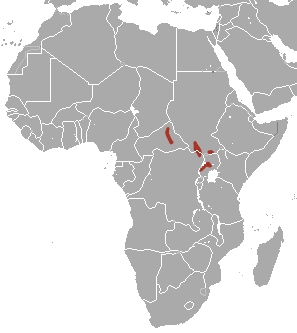
The African forest elephant is one of the two living species of African elephant. It is native to humid tropical forests in West Africa and the Congo Basin. It is the smallest of the three living elephant species, reaching a shoulder height of 2.4 m. As with other African elephants, both sexes have straight, down-pointing tusks, which begin to grow once the animals reach 1–3 years old. The forest elephant lives in highly sociable family groups of up to 20 individuals. Since they forage primarily on leaves, seeds, fruit, and tree bark, they have often been referred to as the 'megagardener of the forest'; the species is one of many that contributes significantly to maintaining the composition, diversity and structure of the Guinean Forests of West Africa and the Congolese rainforests. Seeds of various plants will go through the elephant’s digestive tract and eventually pass through in the animal’s droppings, thus helping to maintain the spread and biodiversity of the forests.
Mareya is a plant genus of the family Euphorbiaceae, first described as a genus in 1860. It is native to tropical western and central Africa.
Cyttaranthus is a plant genus of the family Euphorbiaceae first described as a genus in 1955. It contains only one known species, Cyttaranthus congolensis, native to tropical Africa.

Ancistrocladus is a genus of woody lianas in the monotypic family Ancistrocladaceae. The branches climb by twining other stems or by scrambling with hooked tips. They are found in the tropics of the Old World.

The many-banded snake, also known commonly as the burrowing cobra, is a species of venomous snake in the family Elapidae. The species is native to Central Africa. There are three recognized subspecies.

Pousargues's mongoose, also known as the African tropical savannah mongoose, is a mongoose native to Central Africa. It is listed as data deficient on the IUCN Red List as little is known about its distribution and ecology. It is the only species in the genus Dologale.

Allen's spotted bat is a species of vesper bat in the family Vespertilionidae found in the Central African Republic, the Democratic Republic of the Congo, Kenya, and Uganda. It is found in subtropical or tropical moist lowland forests.
The African smoky mouse or smokey heimyscus is a species of rodent in the family Muridae. It is the only species in the genus Heimyscus.

Berlinia is a genus of flowering plants in the family Fabaceae. It includes 21 species of trees native to sub-Saharan Africa, ranging from Guinea to Chad, Tanzania, Mozambique, and Angola.

Crateranthus is a genus of woody plant in the family Lecythidaceae, first described as a genus in 1913. It is native to tropical Africa.
The brown nightjar is a species of nightjar in the family Caprimulgidae. It is the only species in the genus Veles. It is found in Cameroon, Central African Republic, Republic of the Congo, Democratic Republic of the Congo, Ivory Coast, Gabon, Ghana, and Liberia.

The yellow-throated leaflove is a species of leaflove in the bulbul family of passerine birds. It is the only species of the monotypic genus Atimastillas. The yellow-throated leaflove is found in western and central Africa. Its natural habitats are subtropical or tropical dry forests, moist savanna, and subtropical or tropical moist shrubland.
The bob-tailed weaver is a species of bird in the family Ploceidae. It is monotypic within the genus Brachycope. It is found in Cameroon, Central African Republic, Republic of the Congo, and Democratic Republic of the Congo.

The Aba roundleaf bat, also known as the Aba leaf-nosed bat is a species of bat in the family Hipposideridae. It is found in West Africa along the southern coast from Nigeria to Senegal. Populations have also been noted in Sudan and Uganda. Its natural habitats are subtropical or tropical moist lowland forests, dry and moist savannas, and caves.

The Trevor's free-tailed bat is a species of bat in the family Molossidae. It is found in Central and West Africa. Its natural habitats are subtropical or tropical dry forests and moist savanna.

The Bunyoro rabbit or Central African rabbit is a species of mammal in the family Leporidae. It is monotypic within the genus Poelagus. It is found in central Africa and its typical habitat is damp savannah, often with rocky outcrops.

Nauclea diderrichii is a species of tree of the genus Nauclea in the family Rubiaceae. It is known by the common names bilinga, aloma, badi, kusia and opepe.
Hylodendron is a genus of flowering plants in the family Fabaceae. It belongs to the subfamily Detarioideae. It contains a single species, Hylodendron gabunense, a tree native to Nigeria and west-central tropical Africa, where it grows in Guineo-Congolian forest. It is a tall and thin-boled tree with sharp buttresses, and is armed with woody spines.
Cyclocotyla is a genus of plants first described in 1908. It contains only one known species, Cyclocotyla congolensis, native to central Africa.

Landolphia is a genus of flowering plants in the family Apocynaceae first described as a genus in 1806. They take the form of vines that scramble over host trees. Landolphia is native to tropical Africa.














